Looking for an impressive yet easy fish recipe? This gorgeous swordfish dish is packed with flavor, and you’ll have it on the table in 30 minutes. The gremolata salsa comes together super fast, and the relish – made with cherry tomatoes and olives – gets a brief cook on the stove while the fish finishes in the oven. Speaking of which, swordfish is a meaty, hearty fish that stands up to a variety of cooking methods, but when you’re dealing with thick-cut pieces like steaks it can be difficult to cook them evenly if you do it entirely on the stove. By the time the center is cooked the exterior often ends up dried out and leathery, and there’s no turning back from that. The solution? Pan-roasting. Start the swordfish steaks in a hot pan to brown one side, then flip them over and transfer the pan to a preheated oven to finish cooking. Both sides get nicely browned, and the fish cooks through evenly without becoming dry or tough.
We’ve just entered prime citrus season which means that two of my absolute favorite ingredients – blood oranges and Meyer lemons – are available now. For the record, I’m a citrus fiend. When I was a kid I used to suck on lemon slices. (For real. And I don’t recommend it if you’re fond of your tooth enamel.) Anyway, suffice to say that I adore tart flavors and I use fresh lemon and lime year-round. Meyer lemons and blood oranges are special, though. Their flavors are more floral and complex than their conventional counterparts, and Meyer lemons aren’t as bracingly acidic so you can really highlight them without making a dish overwhelmingly mouth-puckering.
After zesting the citrus so I can use the zest for the salsa, I cut off the peel and all the white membrane to slice out “supremes,” which is just a fancy way of describing the segments of flesh without any membrane or pith attached. If you don’t know how to do this and want to learn, I’m sure there are plenty of YouTube videos available. Fortunately with Meyer lemon and blood orange, as long as you do a relatively thorough job of peeling off the white pith under the zest you don’t have to go to the trouble of cutting supremes. Just separate the segments and chop them.
When I can get my hands on these beautiful fruits I find every possible excuse to cook with them, and in this recipe we’re taking advantage of the entire fruit, including the outer zest which contains fragrant, flavorful oils. Particularly since you’ll be consuming the zest I highly recommend using organic citrus, but if you can only source conventional, scrub them thoroughly with a solution of 3 parts water to 1 part vinegar, and rinse well. Feel free to use a standard navel orange if you can’t find blood oranges. If Meyer lemons aren’t available in your area you can substitute a standard lemon, but I’d suggest using only half the lemon and supplementing with an extra half of an orange to keep the acidity and tartness of the dish in check. (If you’re fortunate like me and have access to pink or “variegated” lemons, use one of those instead; they’re also milder than yellow lemons.)
In addition to my beloved Meyer lemon and blood orange, the warm relish features sweet cherry tomatoes, briny olives and capers, savory garlic, and a touch of smoked paprika. The relish comes together almost as quickly as the salsa does.
When first cooking the tomatoes for the relish you don’t want to break them down too much, just get them slightly soft with maybe a couple of browned spots. As long as your pan is sufficiently hot when you add them, that shouldn’t take more than two minutes (be sure to toss them several times).
There is so much flavor packed into this relish! Don’t you want to dig into it with a spoon? (I may or may not have done that more than once when I was testing the recipe.)
The salsa is inspired by gremolata, which is a classic condiment commonly made of minced parsley, lemon zest and garlic. Here I’ve turned it into a riff on salsa verde or chimichurri. Aged sherry vinegar lends another layer of earthy, mellow acidity, fruity olive oil adds unctuous richness, and the zest of blood orange contributes a complex floral sweetness. I like to mince the herbs by hand and grate the garlic on a fine microplane, but if you’d rather pulse everything together in a food processor or blender, go right ahead. Just don’t blitz it into oblivion – you want it to be a textured mixture with visible bits of parsley and zest, not a uniform sauce.
Now grab your chef’s knife and microplane and get cooking! (P.S., you may have noticed some gorgeous splashes of bright purple on my plate – I like to serve this over some type of hearty winter “greens,” and this time around it was radicchio agrodolce with currants. The sweet and sour notes layer perfectly with the flavors from the citrus and vinegar that are already in the dish.)
- For Gremolata Salsa
- 45 ml (3 Tbsp) olive or avocado oil
- 30 ml (2 Tbsp) aged sherry vinegar
- Zest of one well-scrubbed organic¹ blood orange or navel orange
- Zest of one well-scrubbed organic Meyer lemon
- 1 cup loosely packed Italian parsley leaves (from 1 standard bunch), minced
- 1 clove garlic, grated or very finely minced
- Kosher salt
- Freshly ground pepper to taste
- For Fish
- 15 ml (1 Tbsp) olive oil
- Four wild-caught swordfish steaks² (6 ounces each)
- ⅛ tsp smoked paprika
- Kosher salt
- Freshly ground black pepper
- For Relish
- 15 ml (1 Tbsp) olive oil
- 1 lb cherry tomatoes, halved
- Pinch of crushed red pepper flakes
- Pinch of smoked paprika
- Kosher salt
- 15 ml (1 Tbsp) aged sherry vinegar
- 2 cloves garlic, thinly sliced
- Segments of 1 large organic blood orange or navel orange, chopped
- Segments of 1 large organic Meyer lemon, chopped
- 5 oz (about 36) mixed pitted olives, halved (or quartered if very large)
- 1 oz brine-packed capers, drained (yield 2 heaping tablespoons)
- Freshly ground black pepper
- Preheat oven to 400 before you begin your prep.
- Make the Salsa: In a small bowl whisk together olive oil, vinegar, orange and lemon zest, minced parsley and grated garlic. Season to taste with salt and pepper. Set aside.
- Cook the fish: Heat the oil in a large ovenproof skillet over medium-high heat. Season fish generously on both sides with salt and pepper, and sprinkle with smoked paprika. Add the fish to the pan and cook 2-3 minutes or until steaks are nicely browned on the bottom and release easily from the pan. Carefully flip the fish over, transfer the pan to the oven, and roast for 5-8 minutes until just cooked through. (Cooking time will depend on the thickness of the steaks.)
- While fish is roasting, make the relish: Heat olive oil in a skillet over medium-high heat until shimmering. Add tomatoes (be careful - the moisture from the tomatoes may cause the oil to spatter), crushed red pepper, smoked paprika and a pinch of salt. Cook, tossing frequently, until tomatoes are somewhat softened and lightly browned in a few spots, about 2 minutes. Add sherry vinegar and swirl pan or scrape with a wooden spoon to loosen any bits of tomato that are stuck to the bottom. Add garlic and cook for 1-2 minutes until translucent. Add orange and lemon segments, olives, capers, and 2-3 grinds of black pepper. Toss everything together and cook 1-2 more minutes until everything is heated through and citrus begins to break down. Taste for seasoning and add a pinch of salt if necessary.
- Serve: Transfer swordfish steaks to plates, spoon relish over steaks, and drizzle with salsa.
²If you don't have access to wild-caught swordfish or you just aren't a fan, substitute mahi-mahi, halibut or yellowfin tuna. Be sure to adjust cooking time and doneness accordingly. (I recommend cooking tuna steaks to medium at most; I prefer mine rare to barely medium-rare).
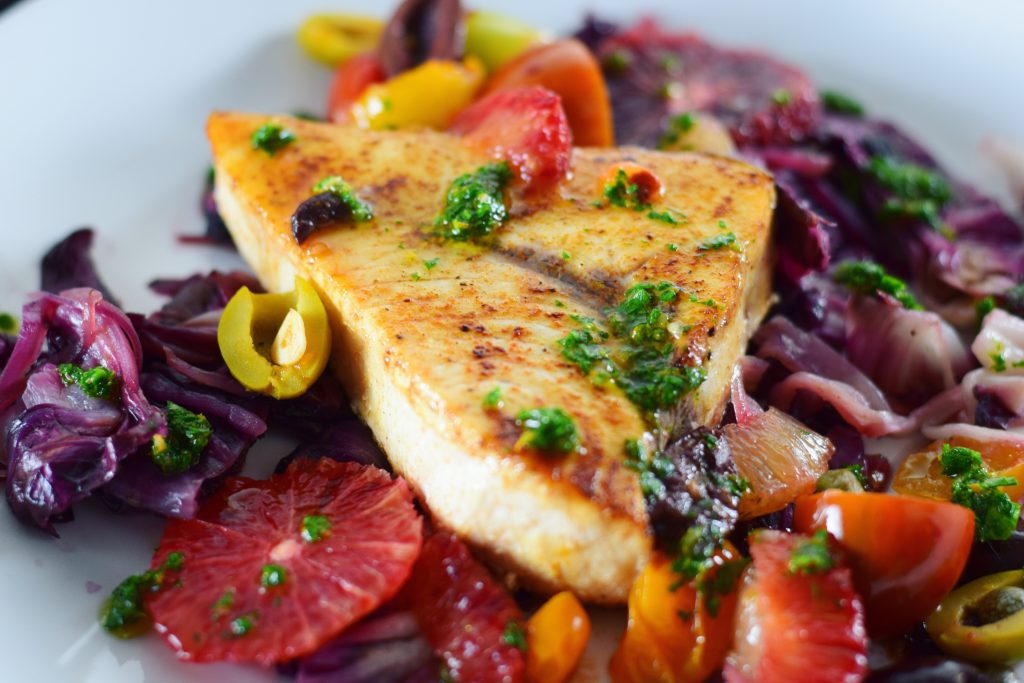
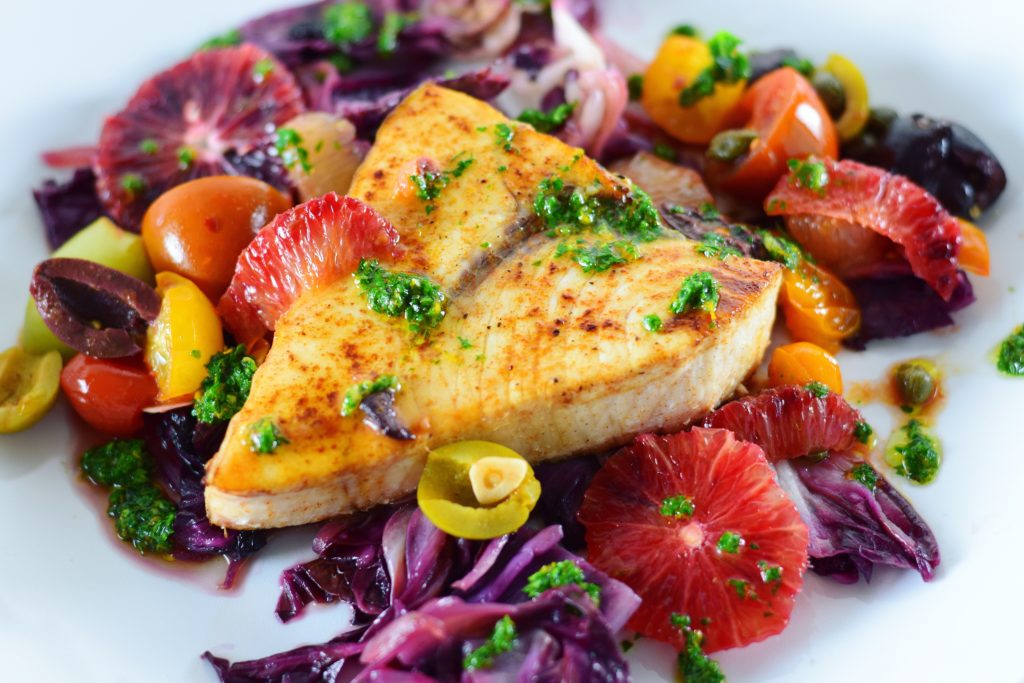
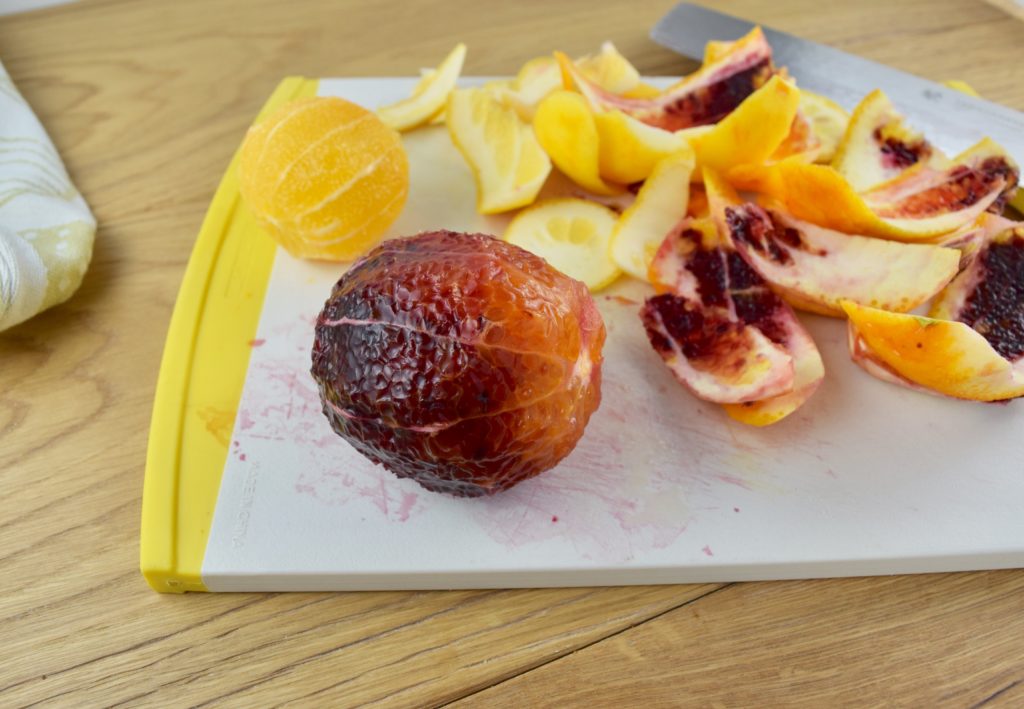
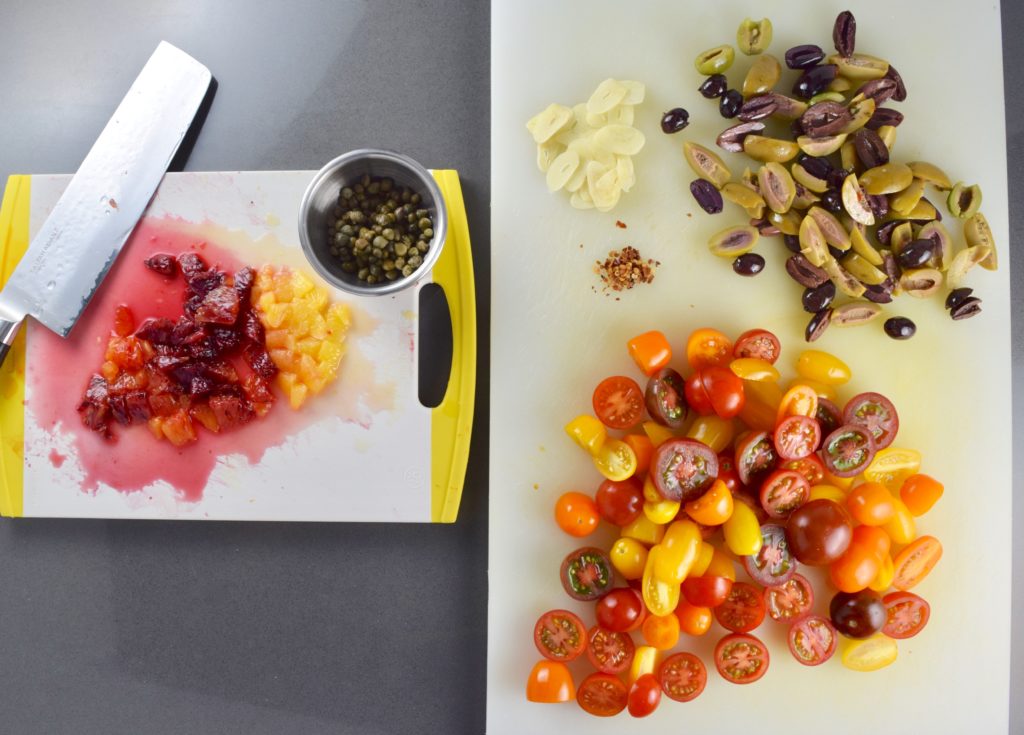
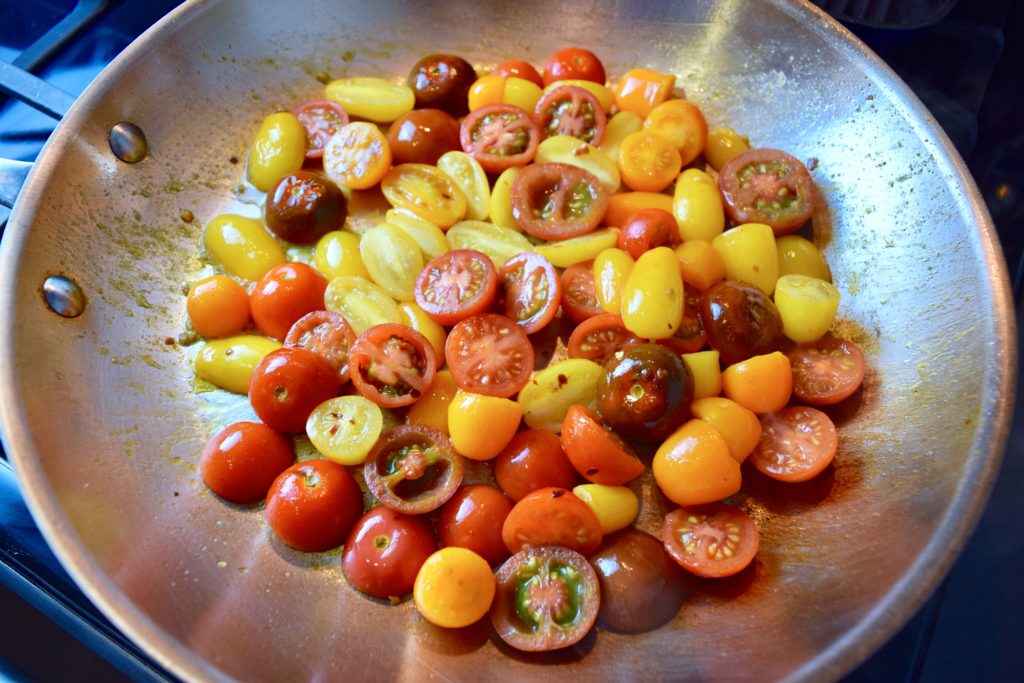
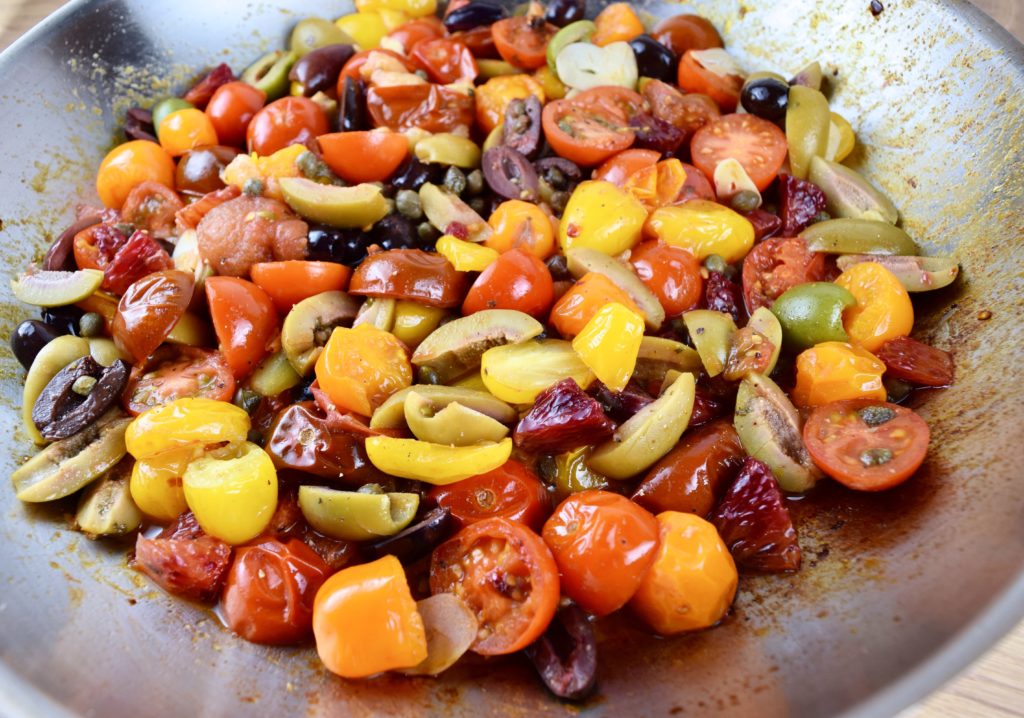
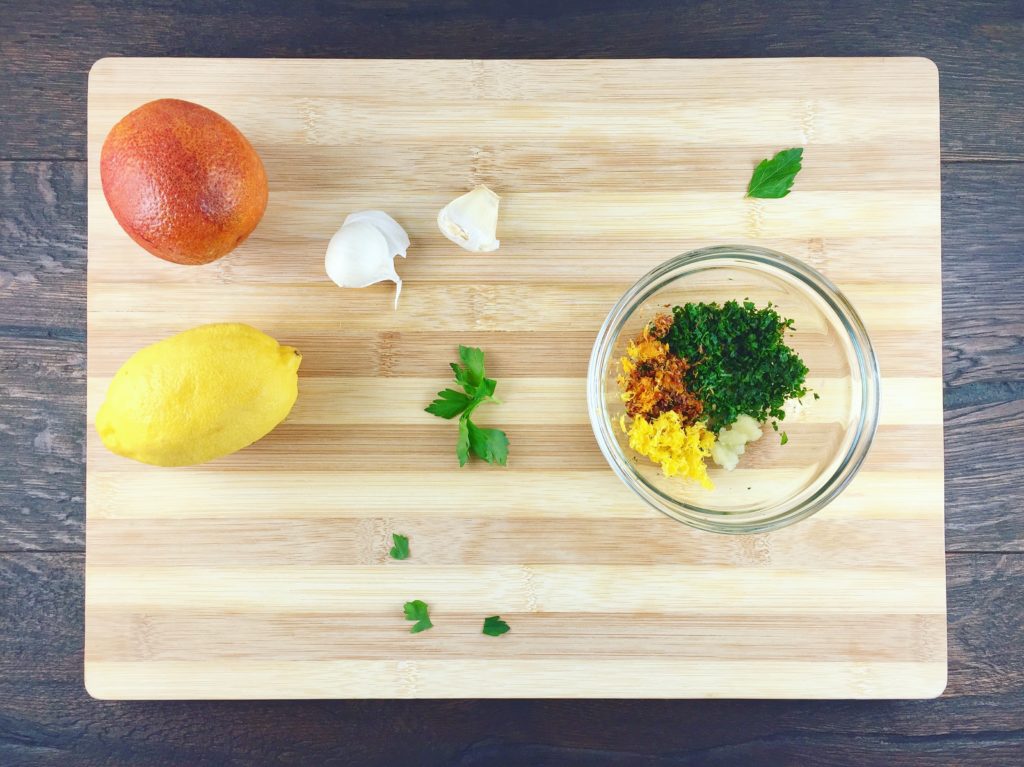
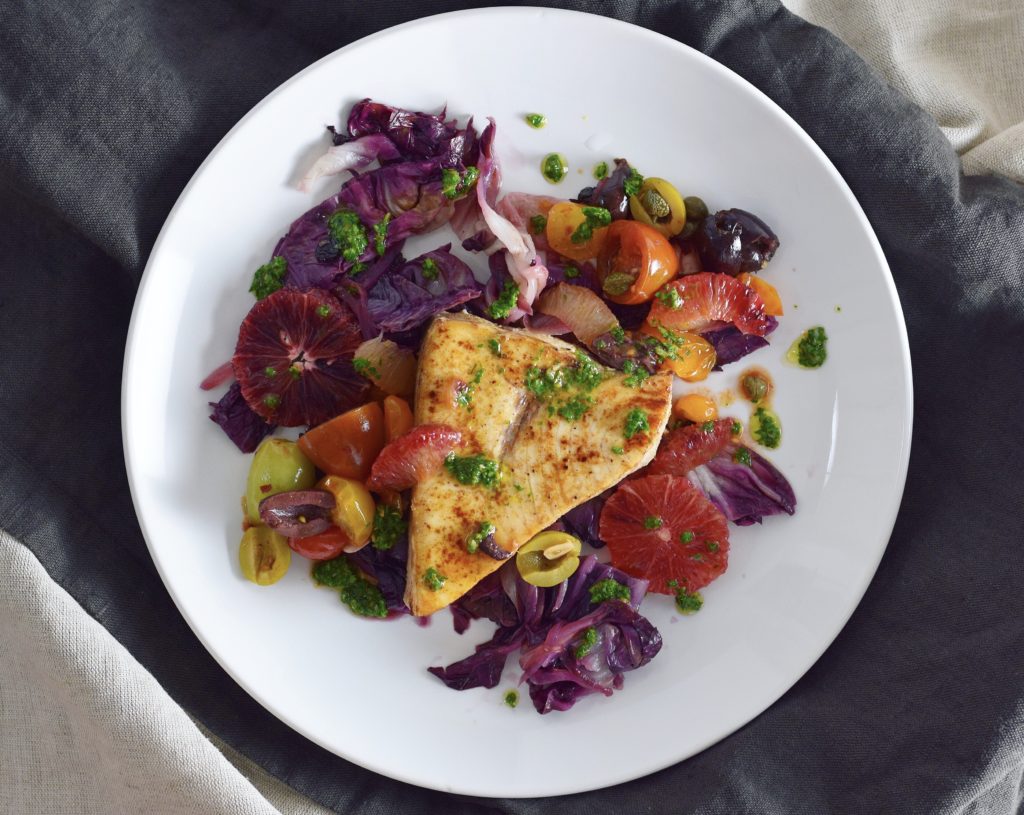


[…] clean all the peel and pith off the orange to get those beautiful slices? I pulled this photo from another post to show you what the orange should look like before you slice it. To get it to this point, cut off […]